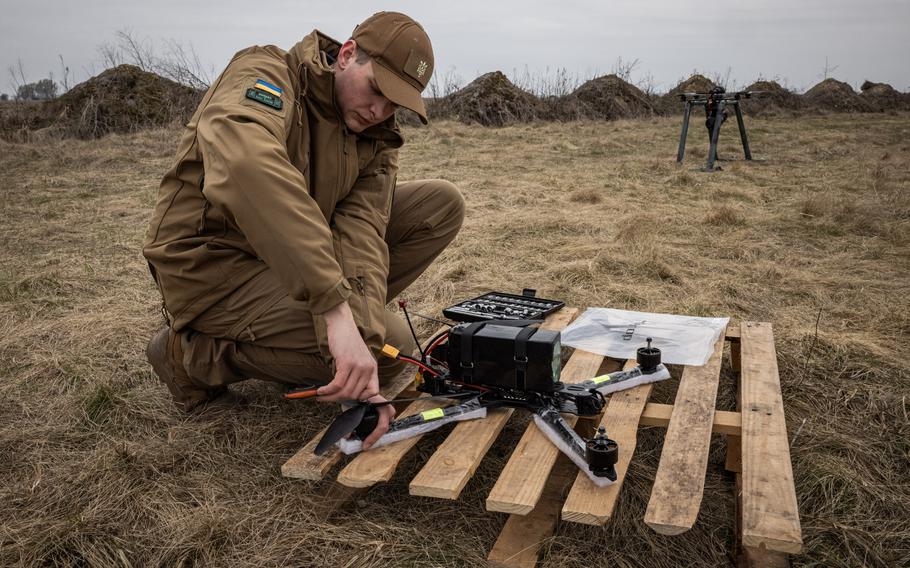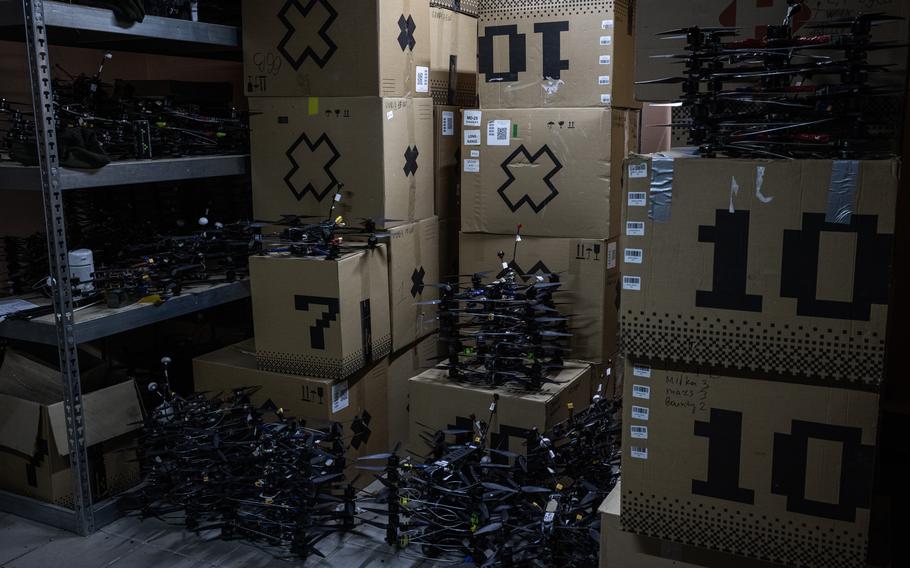Europe
Ukraine scrambles to overcome Russia’s edge in fiber-optic drones
The Washington Post May 23, 2025

Dmytro Romanchenko, director of Raptor Engineering, adjusts a fiber-optic drone before a test in central Ukraine. (Ed Ram/The Washington Post)
SUMY, Ukraine — Ukrainian soldiers had grown used to the deadly drones stalking their vehicles and chasing them through doors and windows — until they met ones they couldn’t stop.
New drones were swarming the battlefield and didn’t rely on jammable radio signals like the older, simpler models — these were controlled instead by tiny cables as thin as thread stretching back to the operator.
For months, Russia has ramped up its deployment of fiber-optic drones, which are steered by the same data-transporting cables made of glass that revolutionized high-speed internet access. While the cables can occasionally tangle, cutting off the signal, they also give the weapon a major advantage because they cannot be disrupted by jamming systems.
Russian troops have used the weapons, which have a range of up to 12 miles, to destroy Ukrainian equipment and control key logistics routes, particularly in Russia’s western Kursk region, where Ukrainian troops say the new technology contributed to their recent painful retreat.
Russia’s fiber-optic drones, which have a longer battery life and more-precise targeting than wireless models, vastly outnumbered Ukraine’s drones on the battlefield in Kursk, giving Russia a key advantage and making movement so risky that Ukrainian troops were at times stranded on the front line without food, ammunition or escape routes, soldiers said.
Ukraine is also using fiber-optic drones in Kursk and elsewhere, though in significantly smaller numbers as it races to catch up with Russia’s mass production of the devices, in what soldiers and experts describe as the first time Russia has surpassed Ukraine in front-line drone technology since the full-scale invasion in 2022.
Russia’s widespread use of the drones has given Moscow, which already outmans and outguns Ukraine, another military advantage at a critical moment for Kyiv, with the White House pushing for a quick peace deal and the future of U.S. military aid to the embattled country still unclear. This upper hand further contributes to Russia’s confidence in victory and reluctance to agree to a ceasefire.
On its face, attaching a cable to a once-wireless drone may seem like a technological step back — and there are some disadvantages, including the risk of a tangle. But the adjustment has generally made these self-detonating drones more deadly.
“What we’re seeing in Ukraine is a revolution in uncrewed warfare,” said Andrew Coté, a former senior U.S. defense official and now chief of staff for Brinc Drones, a U.S. company that has worked in Ukraine but has not yet produced drones made with fiber-optic technology. The fiber-optic drones in Russia and Ukraine transmit information more securely and can better pinpoint targets, despite some limitations including distance, he added.
U.S. defense companies are monitoring the use of tethered drones as they have other drone innovations in Ukraine, which has served as a testing ground for the latest developments in battlefield technology.
The fiber-optic weapons are a fairly simple evolution of the cheap first-person-view (FPV) drones Ukrainian troops rigged with explosives in 2022 to remedy their lack of more-powerful munitions. Costing a few hundred dollars and small enough for a soldier to hold in one hand — but powerful enough to disable a tank — FPV drones quickly revolutionized combat and emerged as a front-line weapon of choice for Russia and Ukraine.
The FPVs, fitted with a small camera and carrying explosives, are typically operated by troops stationed well away who wear headsets to watch the flight path in real time. The devices detonate by crashing directly into a target, which can be more than 12 miles from the launch point — making them an affordable alternative to expensive artillery for closer-range strikes. FPVs have proved so deadly and dangerous in Ukraine that their use has spread to other battlefields, including in West Africa and Syria.
The counter to this form of warfare has been the electronic jamming technology that both sides now equip their vehicles and positions with.
Fiber-optic drones, however, receive their signals from the cable that unspools as the device flies, and the only way to stop such a drone is to shoot it out of the sky.
The cable greatly improves image quality and allows pilots to navigate more-complicated landscapes without losing their connection. They are also able to fly closer to the ground, making it easier to sneak up on enemy troops and perform more-complicated maneuvers, although certain sharp turns can be hampered by the cable.
Longer battery life means they can spend more time waiting for a target. But these advantages come with a cost: One drone can run more than twice the price of its predecessor.
Ramped-up demand
Fiber-optic drones remain in the minority on the front line, but demand from Ukrainian troops has dramatically increased in recent months, said Mykhailo Fedorov, Ukraine’s minister for digital transformation, who is deeply involved in drone development and weapons distribution.

Piles of drones in a production facility in eastern Ukraine last month. (Ed Ram/The Washington Post)
Of Ukraine’s roughly 500 drone manufacturers, he said, at least 15 are now developing fiber-optic drones. An additional 20 are making the cylindrical coils that carry the cable, which is still being imported for now.
Fedorov has tracked the demand through his office’s marketplace website, which allows Ukrainian troops to buy fiber-optic drones and other weapons through a payment system, or by cashing in “points” they earn after providing evidence they have destroyed Russian equipment.
“You can use it in almost every weather condition and on every terrain,” he said, including in urban areas. “Definitely everyone needs fiber-optic drones.”
The next step in defending against these drones will be to find ways to quickly trace the tangled cables back to the launching points and identify and target key military positions. Whether Russia or Ukraine will hold the front-line drone advantage in the future, Fedorov said, “depends on who will find the pathway and identify the starting point first.”
Oleksandr Shulga, who oversees sales for a company creating the plastic coils in Ukraine, said it is making at least 1,500 a week and will soon run tests on its own fiber-optic FPV, named “the spider.” Its rapidly unspooling coil will allow drone operators to fly the devices at nearly 70 mph, he said.
‘A huge advantage in Kursk’
For the Ukrainians fighting in Russia’s Kursk region, the first sign that this new type of drone was in play was pretty clear: Troops noticed that their electronic warfare systems were no longer intercepting drones. Those lucky enough to return from missions would do so with their cars covered in webs of thin, translucent cables. Infantry troops began to trip as their feet got tangled in the mess left behind. From the bird’s-eye view of their own drones, Ukrainians could see the glint of abandoned Russian cables littering the landscape.
By mid-February, through a mix of regular FPVs and fiber-optic drones, Moscow had in its sights the last road linking Ukraine to the occupied Russian town of Sudzha. Ukrainian troops had once called the route — which they relied on for food and ammunition deliveries to the front line — a “road of life.”
It quickly became a death trap.
Boxer, 28, a Ukrainian drone platoon commander who has been fighting in Kursk for nine months and does not have fiber-optic drones, said that by March, so many Ukrainian vehicles were being destroyed on the logistics route that surviving soldiers often trekked back to Ukraine on foot. Soldiers passing by in undamaged cars didn’t dare slow down to help, knowing they could be next.
Only heavy rain or fog could disrupt the fiber-optic drones. Ukrainian troops in trenches in Sudzha knew that when they “saw clear skies, there would be no deliveries,” said Oleh, another soldier.
The soldiers, like some others in this article, spoke on the condition that they be identified by their call sign or first name because they were not authorized to discuss operations in Kursk.
Russia “had a huge advantage in Kursk due to the use of fiber-optic drones because they basically killed Ukraine’s logistics,” said one 24-year-old drone commander in Ukraine’s 47th Brigade, who spoke on the condition of anonymity to avoid repercussions from higher command.
Some essential weapon and food deliveries to the front were halted and missions to retrieve the wounded delayed, especially during daytime. “People with amputations … were rotting while waiting for evacuations,” he said.
Throughout this chaos, he added, even most of the “experienced, leading Ukrainian drone operators and units in Kursk were still relying on non-fiber-optic drones.”
Russia’s use of the fiber-optic technology was one of several factors contributing to the loss of that essential road, said Oleksandr, 40, a Ukrainian officer overseeing intelligence operations in Kursk. And once the road was lost, he said, Ukraine’s eventual retreat from Sudzha “was only a matter of time.”
Russia claimed control of the town in March.
A rush to build
Elsewhere on the front line, Ukrainian troops are sprinting to build fiber-optic drones themselves — opting for newer, lightweight Ukrainian components to limit their imports from Asia.
In a basement in northeast Ukraine, soldiers in the Achilles Regiment are tasked with repairing and building drones for their fellow troops. Five to 10 percent of the devices are fiber-optic, and even a tiny detail — like a simple speck of dirt on a cable — could mean the difference between life and death.
The troops build three sizes of fiber-optic drones, with ranges of six to 12½ miles, depending on the size of the attached coil. Bigger and farther isn’t always better, said Achilles commander Yuriy Fedorenko, whose troops hunt Russian tanks with the drones. “The bigger the distance, the bigger the coil; the bigger the coil, the bigger the drone; the bigger the drone, the more likely it is to be shot down,” he said.
Fedorenko said the fiber-optic cable allows pilots to navigate wooded and urban areas that once had been off-limits because obstacles disrupted radio signals. The developments have given him hope that more changes are on the way — including using artificial intelligence to improve targeting and reduce the burden on front-line troops.
But for now, even skilled drone pilots must dedicate time to learning the intricacies of the fiber-optic flight process to avoid catching the cable in a drone’s propellers or on obstacles like tree branches. It takes only one knot to cut the signal, rendering the mission and the drone useless. But soldiers say those complications are worth it when a drone flies without trouble, straight into a target.
The very concept of attaching a cable to a drone might sound counterintuitive, Dmytro Semkiv, an engineer building the drones in the Achilles workshop acknowledged. But sometimes, he said, “genius ideas are really simple.”